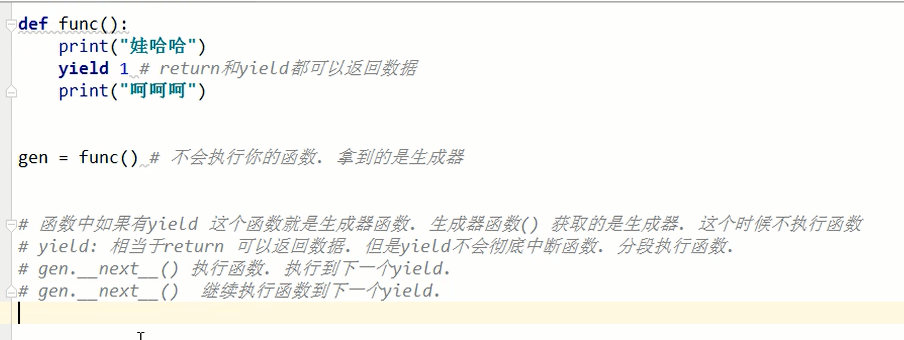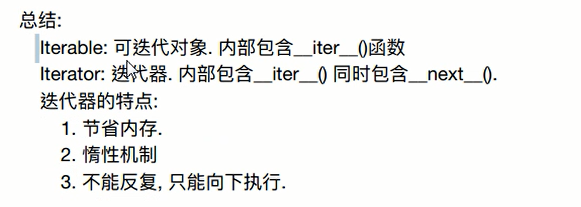生成器(generator)概念
生成器不会把结果保存在一个系列中,而是保存生成器的状态,在每次进行迭代时返回一个值,直到遇到StopIteration异常结束。
生成器语法
- 生成器函数: 在函数中如果出现了yield关键字,那么该函数就不再是普通函数,而是生成器函数。
但是生成器函数可以生产一个无线的序列,这样列表根本没有办法进行处理。
yield 的作用就是把一个函数变成一个 generator,带有 yield 的函数不再是一个普通函数,Python 解释器会将其视为一个 generator。

下面为一个可以无穷生产奇数的生成器函数。
def odd():
n=1
while True:
yield n
n+=2
odd_num = odd()
count = 0
for o in odd_num:
if count >=5: break
print(o)
count +=1
当然通过手动编写迭代器可以实现类似的效果,只不过生成器更加直观易懂
class Iter:
def __init__(self):
self.start=-1
def __iter__(self):
return self
def __next__(self):
self.start +=2
return self.start
I = Iter()
for count in range(5):
print(next(I))
题外话: 生成器是包含有__iter__()和__next__()方法的,所以可以直接使用for来迭代,而没有包含StopIteration的自编Iter来只能通过手动循环来迭代。
>>> from collections import Iterable >>> from collections import Iterator >>> isinstance(odd_num, Iterable) True >>> isinstance(odd_num, Iterator) True >>> iter(odd_num) is odd_num True >>> help(odd_num) Help on generator object: odd = class generator(object) | Methods defined here: | | __iter__(self, /) | Implement iter(self). | | __next__(self, /) | Implement next(self). ......
看到上面的结果,现在你可以很有信心的按照Iterator的方式进行循环了吧!
在 for 循环执行时,每次循环都会执行 fab 函数内部的代码,执行到 yield b 时,fab 函数就返回一个迭代值,下次迭代时,代码从 yield b 的下一条语句继续执行,而函数的本地变量看起来和上次中断执行前是完全一样的,于是函数继续执行,直到再次遇到 yield。看起来就好像一个函数在正常执行的过程中被 yield 中断了数次,每次中断都会通过 yield 返回当前的迭代值。
生成器支持的方法
close()
手动关闭生成器函数,后面的调用会直接返回StopIteration异常。
>>> def g4(): ... yield 1 ... yield 2 ... yield 3 ... >>> g=g4() >>> next(g) 1 >>> g.close() >>> next(g) #关闭后,yield 2和yield 3语句将不再起作用 Traceback (most recent call last): File "<stdin>", line 1, in <module> StopIteration
send()
生成器函数最大的特点是可以接受外部传入的一个变量,并根据变量内容计算结果后返回。
这是生成器函数最难理解的地方,也是最重要的地方,实现后面我会讲到的协程就全靠它了。
def gen():
value = 0
while True:
receive = yield value
print(receive)
if receive == 'e':
break
value = receive
g = gen()
print(g.send(None))
print(g.send(1))
print(g.send(2))
print(g.send('e'))
执行流程:
- 通过g.send(None)或者next(g)可以启动生成器函数,并执行到第一个yield语句结束的位置。
此时,执行完了yield语句,但是没有给receive赋值。
yield value会输出初始值0
注意:在启动生成器函数时只能send(None),如果试图输入其它的值都会得到错误提示信息。 - 通过g.send(1),会传入1,并赋值给receive,然后计算出value的值,并回到while头部,执行yield value语句后停止。
此时yield value会输出1,然后挂起。 - 通过g.send(2),会重复第2步,最后输出结果为2
- 当我们g.send('e')时,程序会执行break然后推出循环,最后整个函数执行完毕,所以会得到StopIteration异常。
最后的执行结果如下:
0 1 1 2 2 e StopIteration
throw()
用来向生成器函数送入一个异常,可以结束系统定义的异常,或者自定义的异常。
throw()后直接跑出异常并结束程序,或者消耗掉一个yield,或者在没有下一个yield的时候直接进行到程序的结尾。
def gen():
while True:
try:
yield 'normal value'
yield 'normal value 2'
print('here')
except ValueError:
print('we got ValueError here')
except TypeError:
break
g=gen()
print(next(g))
print(g.throw(ValueError))
print(next(g))
print(g.throw(TypeError))
输出结果为:
normal value
we got ValueError here
normal value
normal value 2
Traceback (most recent call last):
File "h.py", line 15, in <module>
print(g.throw(TypeError))
StopIteration
解释:
- print(next(g)):会输出normal value,并停留在yield 'normal value 2'之前。
- 由于执行了g.throw(ValueError),所以会跳过所有后续的try语句,也就是说yield 'normal value 2'不会被执行,然后进入到except语句,打印出we got ValueError here。
然后再次进入到while语句部分,消耗一个yield,所以会输出normal value。 - print(next(g)),会执行yield 'normal value 2'语句,并停留在执行完该语句后的位置。
- g.throw(TypeError):会跳出try语句,从而print('here')不会被执行,然后执行break语句,跳出while循环,然后到达程序结尾,所以跑出StopIteration异常。
下面给出一个综合例子,用来把一个多维列表展开,或者说扁平化多维列表
def flatten(nested):
try:
# 如果是字符串,那么手动抛出TypeError。
if isinstance(nested, str):
raise TypeError
for sublist in nested:
# yield flatten(sublist)
for element in flatten(sublist):
yield element
# print('got:', element)
except TypeError:
# print('here')
yield nested
L = ['aaadf', [1, 2, 3], 2, 4, [5, [6, [8, [9]], 'ddf'], 7]]
for num in flatten(L):
# print(num)
pass
yield from
yield产生的函数就是一个迭代器,所以我们通常会把它放在循环语句中进行输出结果。
有时候我们需要把这个yield产生的迭代器放在另一个生成器函数中,也就是生成器嵌套。
比如下面的例子:
def inner():
for i in range(10):
yield i
def outer():
g_inner=inner() #这是一个生成器
while True:
res = g_inner.send(None)
yield res
g_outer=outer()
while True:
try:
print(g_outer.send(None))
except StopIteration:
break
此时,我们可以采用yield from语句来减少我么你的工作量。
def outer2():
yield from inner()
总结

- 按照鸭子模型理论,生成器就是一种迭代器,可以使用for进行迭代。
- 第一次执行next(generator)时,会执行完yield语句后程序进行挂起,所有的参数和状态会进行保存。
再一次执行next(generator)时,会从挂起的状态开始往后执行。
在遇到程序的结尾或者遇到StopIteration时,循环结束。 - 可以通过generator.send(arg)来传入参数,这是协程模型。
- 可以通过generator.throw(exception)来传入一个异常。throw语句会消耗掉一个yield。
可以通过generator.close()来手动关闭生成器。 - next()等价于send(None)
面试题
def count_down(n):
while n >= 0:
newn = yield n
if newn:
n = newn
else:
n -= 1
cd = count_down(5)
for i in cd:
print(i, ',')
if i == 5:
cd.send(3)
结果:
5 ,
2 ,
1 ,
0 ,
本文章内容参考链接:https://www.cnblogs.com/jessonluo/p/4732565.html